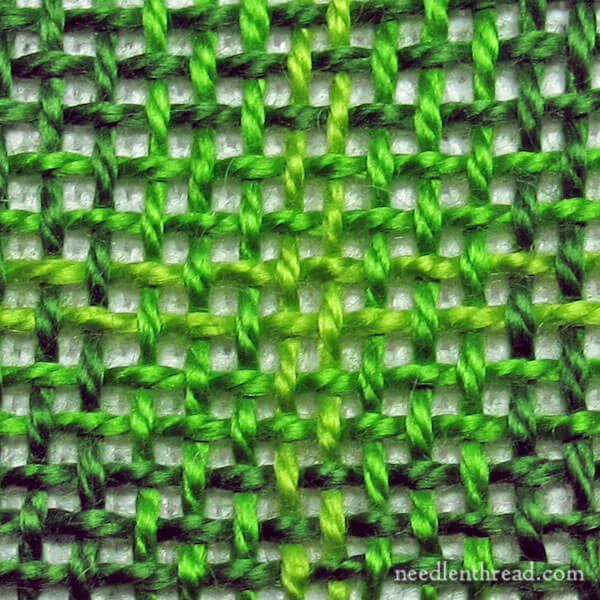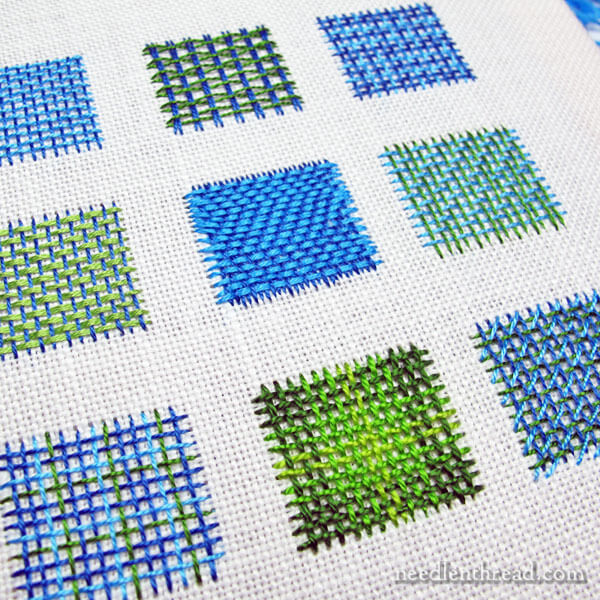Remember last week when we chatted about needle weaving as a filling?
Well, I’m still playing around with the possibilities. See, that’s the problem whenever I engage in any type of sampler. I get Well and Truly Stuck in it.
I’m playing particularly with woven fillings because I’m working on an article for Commonthread by DMC on the same topic. I’ve got a little practice piece that will accompany that article, so I’ll let you know when it’s out. It’s particularly fall-ish, so it’s perfect for this time of year!

Here’s a fun point about the woven stitch, or needle weaving, or basket weave stitch (however you want to call it – I’ve seen it referred to by many names, but it’s all essentially the same stitching technique): you can shade with it.
By working gradually changing shades of color in the warp threads (those are the vertical threads) or in the weft threads (those are the horizontal threads) or in both the warp and the weft threads, you can bring about some interesting shaded effects with this stitching technique.
The image above is a 1″ square of woven stitch worked in #5 pearl cotton. The warp threads progress from dark green on the outside of the square to light green in the middle, working with three shades of green. Then the weft threads do essentially the same thing, from dark on the outside to light on the inside.

What does this mean, when it comes to using this woven filling in practical applications?
Well, when you’re embroidering an object, you can make it look somewhat dimensional by playing with the shades used on either the warp or weft threads (or both).
For example, if you’re embroidering a rounded basket, the vertical warp threads could be dark on the edges and light in the center, to give just a touch of shading on the edges to enhance the dimensional shape of a rounded basket.
My little nine square sampler of woven fillings pictured above was fun to work up, just to play with different possibilities. But, like any sampler project like this, it only fueled my desire to keep playing – and that could be dangerous!
If you want to play about with this type of filling, here are the instructions for the basic woven filling. From there, it’s just a matter of experimenting with different threads, colors, spacing, and weaving direction. You can mix together different types of threads, too, if you want to play with texture.
Now, go forth and play with some stitches!
If you have any questions, comments, or suggestions, feel free to leave a comment below!
You can find plenty of stitches to play with in the Stitch Fun! series here on Needle ‘n Thread. You’ll also find over 75 embroidery stitch videos to help you learn new stitches that you can experiment with. Interested in working a random stitch sampler? You’ll find all kinds of articles related to samplers here on Needle ‘n Thread – feel free browse a bit and explore!







Its harder to tell in the close up, but in the zoomed out picture, your green square looks like a plaid pattern. Neat effect!
Looks like a fun stitch type for Jacobean work fills.
Blue square in center has optical effect.Happy accident or did it take planning? Really like the shading potential.
Hi, Lisa – I was playing with different sequences of weaving the threads on that one. Happy accident and planning at the same time….
I somehow missed that first post. Time gets away from me these days and sometimes I have to play catch up with my emails. 🙁 Glad you had that link so I could read that one as well.
This stitch may have possibilities in my future. 🙂 Thanks Mary, you just keep inspiring…
Dear Mary
I like needle weaving and I like the different shades of light and dark colours that you have chosen for the woven stitch very pretty. I can see lots of possibilities for this type of stitching, these would look lovely on basket weaving or any type of filling and as you say they would be great on a project where you would want dimension. Thanks for sharing your weaving sampler with us and for the links for the basic woven stitch very helpful.
Regards Anita Simmance
Those are wonderful and I can actually imagine them being used in irregular shaped areas. Normally I can only visualize just what you’ve already shared with us. 🙂 I do wonder: with the threads simply woven, it seems they would easily shift out of position with any handling. I’ve seen you couch them before and that would keep them still. But for gift towels or clothing, the regular basket stitch might not be a good idea. Or maybe I’m worrying about nothing. I’m good at that. 🙂
I’ve enjoyed all your samples and examples of basketweave stitch, Mary. So pretty! So versatile! Thanks for the inspiration.
Hi Mary,
You’ve given me a new perspective on plaids in general. I’ll be examining every one I see to try to detect the sequence. I may make new friends. Or wind up in jail. :-).
Thanks,
Georgia
What’s in a name? I always thought basket weave stitch was the needlepoint staple that keeps canvas from warping as it’s apt to do with the continental stitch. The other day when we commented on our favorite stitches someone voted for queen stitch. I hadn’t heard of this one and went looking through all my stitch dictionaries and online resources. I found that queen stitch appeared as renaissance stitch, rococo stitch, and probably others I didn’t spot. The online resources had diagrams but were different in interpretation and shape with the same basic pattern. It’s so fascinating I can spend hours Looking Stuff Up rather than stitching! Best, Charlotte
hello Mary, i`ve just entered a candy store! you make me want to make everything you show to us. although a have done x-stitch all my life and know a lot of embroidery stitches i have never done them except the chain stitch. But you really make me want to try them all.
With every newsletter, i have the idea that an embroidery friend is emailing me. At the end of your email letter i always have to remember that it is you, at the other side of the pound. haha
greetings miek
like the woven stitch. thanks
Dear Tracy,
the weaving pattern which you use is called hopsack (under one, over the next). I wonder what will happen hen you use one of the other weaving patterns (e.g. over two, under the next two; next line shift one to the right, or diamond twill).
Greetings, Johan
This does not pertain to the Basketweave Stitch & Shading article. I just want to thank you so very much for your outstanding tutorial videos. I just finished a sampler and the instructions for a Raised Chain Band, were not very clear. I Googled it, and there it was, Mary, as clear and as simple to follow as could be! So I know if I ever have a question about how to do – or improve – a stitch I will go to Needle n’ Thread first!
Thanks, Jean! I’m so glad the video came in handy!
LOVELY sampler. Amazing how so humble a stitch can produce such a wide variation of effects. Thank you.